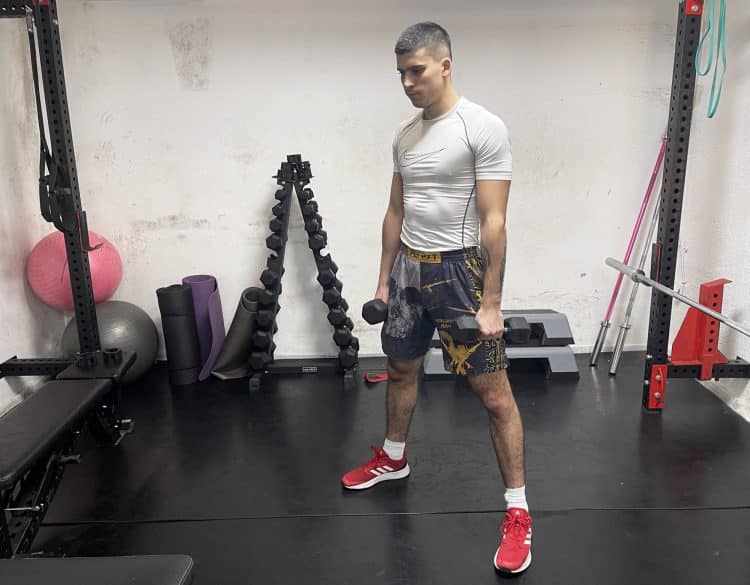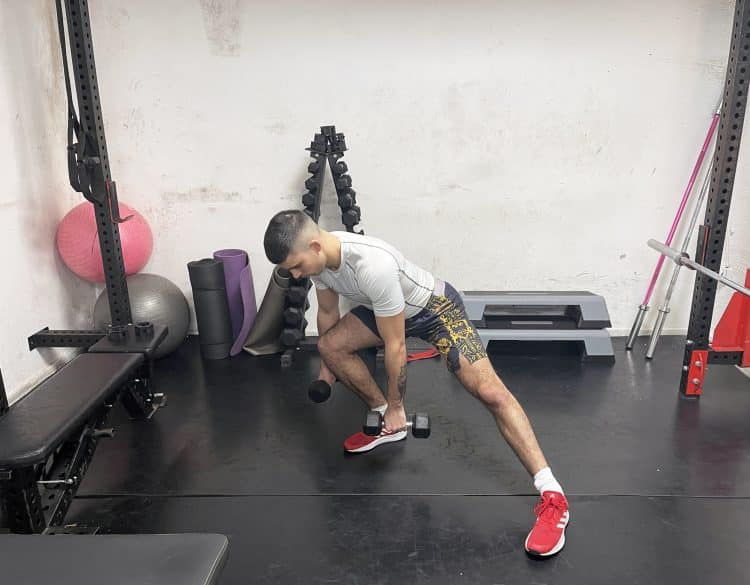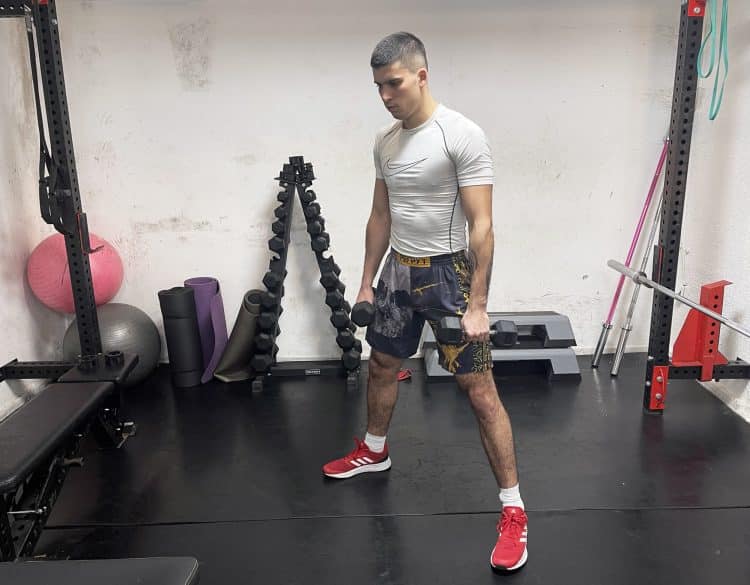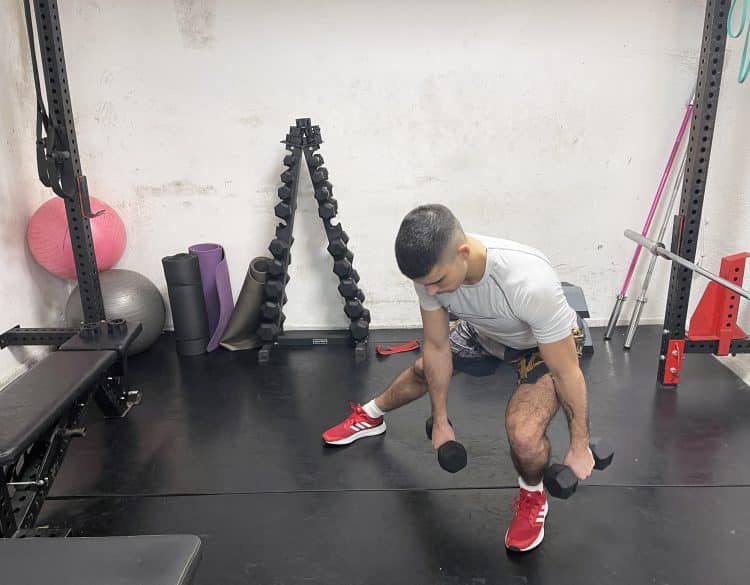Side squats are an excellent squat variation to develop additional leg strength and endurance.
It’s crucial to perform squat variations in your lower body workouts for variety and balanced muscle development.
According to a Plos One study, varying exercise positively enhanced motivation and muscular adaptations in resistance-trained men. (1)
As I gained more training experience and looked to enhance the efficiency of my squat sessions, I introduced various squat variations into my routine. It helped me immensely, not just with strength and muscle gains but also with coordination.
Below, I will teach you how to perform side squats with proper form. I will also elaborate on the most common side squat mistakes, tips, and variations to include in your workouts.
What is a Side Squat?
A side squat, also known as a lateral squat, targets the lower body, emphasizing the glutes, quads, and inner thighs. It involves a lateral movement, stepping to the side while lowering into a squat. This variation not only activates different muscle groups compared to a traditional squat but also enhances balance and agility. Suitable for all fitness levels, side squats can be easily modified to fit any workout routine, making them a versatile and effective exercise for improving functional strength and coordination.
Level Up Your Fitness: Join our 💪 strong community in Fitness Volt Newsletter. Get daily inspiration, expert-backed workouts, nutrition tips, the latest in strength sports, and the support you need to reach your goals. Subscribe for free!
How To Perform Side Squats
Below is a simple step-by-step guide on how to perform side squats with proper form:
Step One — Assume the Starting Position
Pick dumbbells of an appropriate weight. Beginners can also perform bodyweight side squats. Assume a wider-than-shoulder-width stance and turn your toes outward slightly. Hold the dumbbell at your sides or in front of your chest.
Pro Tip: Ensure your knees align with your toes. Keep a slight knee bend to reduce joint stress and maintain balance throughout the exercise.
Step Two — Execute the Lateral Squat Movement
Shift your body weight to the right side and bend your right hip, knee, and ankle simultaneously. Keep the dumbbells on each side of your right knee as you descend. They should slowly lower towards the floor.
Ensure your back is straight throughout the entire exercise. Hold the bottom position, where your thighs are parallel to the floor, for one second. This position will vary depending on your biomechanics, but aim to go as low as possible without compromising the form.
Pro Tip: Perform slow eccentrics. This will increase the muscles’ time under tension. It will also boost your mind-muscle connection and overall muscle hypertrophy.
Step Three — Return to the Starting Position
Reverse the motion to return to the starting position. Simultaneously extend your right ankle, knee, and hip. Ensure your back is straight while doing so.
Pro Tip: Perform this phase of the exercise as fast as you can. This will force additional fast-twitch muscle fibers activation.
Step Four — Perform Lateral Squat on the Other Side
After completing the desired repetitions on one side, switch to the other side. Repeat the lateral squat movement on the other side to ensure balanced muscle development and strength on both sides of your body.
Pro Tip: Focus on maintaining the same range of motion and control as on the first side. This will ensure balanced muscle development and symmetrical strength gains.
Tips For Performing Side Squats
Based on my experience, here are the most important tips for performing side squats:
Proper Breathing Is Crucial
During the eccentric phase, focus on breathing in slowly. Avoid shallow and quick inhales. Additionally, exhale sharply during concentrics. This will elevate your intraabdominal pressure, aiding in both stability and performance.
According to one of the systematic reviews found on the National Center for Biotechnology Information, intrathoracic pressure (ITP), intra-abdominal pressure (IAP), and the Valsalva maneuver (VM) play crucial roles during all spectrums of human activity. (2)
In fact, they increase the tone of your vagus nerve, which decreases your heart rate, alters blood pressure, and boosts trunk stabilization.
Ensure Proper Balance
As mentioned earlier, proper stabilization is crucial for just about any exercise. However, if you are a beginner, you can hold onto a stable surface when performing side squats.
Level Up Your Fitness: Join our 💪 strong community in Fitness Volt Newsletter. Get daily inspiration, expert-backed workouts, nutrition tips, the latest in strength sports, and the support you need to reach your goals. Subscribe for free!
This will help your balance effectively while allowing you to build strength and hypertrophy. However, as you progress and increase your stability during exercise, revert to the original variation without any support.
Include Variations
Exercise variations are crucial for maximizing performance, especially when building strength.
One of my college professors said, “Strength loves diversity.”
She emphasized the importance of incorporating a variety of exercises and suitable variations to optimize performance.
Repetition and Sets
Start with 2-3 sets of 6-12 reps. From there, progress gradually to build strength or muscle hypertrophy. However, if you wish to improve your overall endurance, you may increase the number of reps. Anything between 12 and 25 reps is suitable.
What Mistakes Should I Avoid When Performing Side Squats?
In my experience, these are the biggest mistakes you must avoid:
Excessive Leaning
Leaning forward or backward too much increases injury risk. You must find the sweet spot between hip and knee flexion to remain stable and achieve optimal muscle engagement.
Individual needs vary, but if you find yourself leaning too much toward one side, consider incorporating additional mobility drills into your weekly routine.
Neglecting Balance
You must consciously think about staying stable throughout the entire exercise. In addition to that, to achieve better balance, activate your core musculature. A stable core will help a lot with overall safety and balance during most of the exercises.
Insufficient Range of Motion
If you can’t perform the exercise through a full range of motion, you must improve your mobility. For this exercise, you must improve your hip and ankle mobility. This can be done through mobility and flexibility drills like ankle circles and the pigeon pose. You can allocate an entire training session to mobility work or incorporate these drills into your warm-up routine.
Lifting Too Heavy
When adding weights, you must be cautious not to overextend yourself. It’s not advisable to increase the weight in every single workout session. Even though progressive overload is crucial in building strength and muscle, it’s not feasible to incorporate it into every workout.
Neglecting Warm-up
A proper warm-up is essential for any workout. Failing to warm up adequately can lead to injuries or suboptimal performance.
Warming up to raise your body temperature and activate key muscle groups is a must before diving into any intense workout session. Furthermore, it’s essential to incorporate extra mobility drills and warm-up sets into your routine. This will lower the chance of injury and prime your muscles for your workout.
Side Squat Variations
Below are the best side squat variations to incorporate in your workouts:
Lateral Lunge
Lateral lunge is an excellent dynamic variation that will help you develop inner thigh and glute muscles. It is an excellent addition to your leg workout since it adds versatility while effectively targeting similar muscle groups.
Steps:
- Assume the standing starting position with your feet hip-width apart.
- Extend your hands in front of you or keep them behind your head.
- Ensure your back is straight throughout the entire lift.
- Lunge on the side with your right leg. Bend your right ankle, knee, and hips simultaneously.
- Lower until your thighs are parallel to the ground. Ensure you don’t round your back on the way down. If you do so, immediately stop and return to the starting position.
- Hold the bottom position for one second.
- Reverse the motion by extending your right ankle, knee, and hip.
- Repeat on the other side and alternate for the desired amount of reps.
Pro Tip: Focus on pushing your hips back as you lunge to engage your glutes and hamstrings more effectively. Maintain a tall posture throughout the movement to support proper alignment and balance.
Cossack Squat
Cossack squats are very similar to side squats, except a little movement and rotation in your hips, knees, and ankles. You will be able to achieve much better squat depth with this exercise. It will also help you develop better mobility while increasing your leg strength and endurance.
Steps:
- Assume a standing position with your feet wider than shoulder-width apart.
- Turn your toes slightly outward and ensure your knees are in line with them.
- Keep your arms close to your chest.
- Ensure your back is straight throughout the entire exercise.
- Shift your body weight to the right side and bend your right hip, knee, and ankle simultaneously.
- As you descend, allow the front part of your left foot to lift off the ground.
- Point your left toe towards the ceiling.
- When you enter the bottom position, hold it for one second.
- Reverse the motion and repeat with the left leg.
- Alternate for the desired reps.
Pro Tip: Keep your working leg stable and firmly planted while keeping the toes of the opposite leg pointed toward the ceiling. This will ensure stability and prevent potential strains.
Wrapping Up
Side or lateral squats are an excellent squat variation to add to your leg workouts. Important considerations for side squats include maintaining proper breathing and balance, incorporating variations, and setting appropriate sets and repetitions.
You must avoid excessive leaning, neglecting balance, partial range of motion, lifting too heavy, and neglecting warm-up. In the comments below, let me know your thoughts on side squats and how you implement them in your leg workouts.
References
- Baz-Valle E, Schoenfeld BJ, Torres-Unda J, Santos-Concejero J, Balsalobre-Fernández C. The effects of exercise variation in muscle thickness, maximal strength and motivation in resistance trained men. PLoS One. 2019;14(12):e0226989. Published 2019 Dec 27. doi:10.1371/journal.pone.0226989
- Blazek D, Stastny P, Maszczyk A, Krawczyk M, Matykiewicz P, Petr M. Systematic review of intra-abdominal and intrathoracic pressures initiated by the Valsalva manoeuvre during high-intensity resistance exercises. Biol Sport. 2019;36(4):373-386. doi:10.5114/biolsport.2019.88759
Relevant Articles:
Interested in measuring your progress? Check out our strength standards for Sissy Squat, Squat, Lunge, and more.












